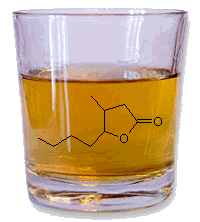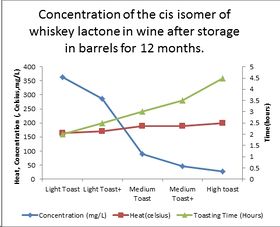Lactone: Difference between revisions
(Created page with "Lactones contribute to the flavor profile of whiskeys and other beverages aged in oak barrels. Lactones contribute significantly to the flavor of fruit, and of unfermented a...") |
(Added Whiskey Lactone section, link, image, removed part that wasn't relevant.) |
||
| (2 intermediate revisions by one other user not shown) | |||
| Line 1: | Line 1: | ||
Lactones contribute to the flavor profile of | [[File:Whiskey lactone glass.gif|thumb|280px|right|This is the chemical structure of a Whiskey Lactone on a glass of Whiskey.]] | ||
[[File:Whiskeylactonetimechart.jpg|thumb|280px|right|Lower toast levels increase the whiskey lactone levels. ]] | |||
Lactones contribute to the flavor profile of [[whiskey]]s and other beverages [[aged]] in [[oak barrel]]s. | |||
Lactones contribute significantly to the flavor of fruit, and of unfermented and fermented dairy products, | The 3S,4S isomer (cis-3-Methyl-4-octanolide), commonly known as whisky lactone or quercus lactone is an important ingredient in the aroma of whiskey (where it was first identified by Suomalainen and Nykänen in 1970),and other alcoholic beverages that have been aged in oak barrels. It is sometimes added to the liquor as a flavoring agent. It has a coconut, celery or fresh wood aroma, that can be detected by humans at the concentration of 1 μg/L in air.[5] A mixture of the cis and trans isomers is repellent for mosquitos and flies. | ||
Lactones contribute significantly to the flavor of [[fruit]], and of unfermented and [[fermented]] dairy products, and are therefore used as flavors and fragrances. Some examples are γ-decalactone (4-decanolide), which has a characteristic [[peach]] flavor; δ-decalactone (5-decanolide), which has a creamy coconut/peach flavour; γ-dodecalactone (4-dodecanolide), which also has a coconut/fruity flavor, a description which also fits γ-octalactone (4-octanolide), although it also has a herbaceous character; γ-nonalactone, which has an intense coconut flavor of this series, despite not occurring in coconut, and γ-undecalactone. | |||
==External links== | ==External links== | ||
* [https://en.wikipedia.org/wiki/Lactone Lactone on Wikipedia] | *[https://en.wikipedia.org/wiki/Lactone Lactone on Wikipedia] | ||
*[https://en.wikipedia.org/wiki/Cis-3-Methyl-4-octanolide Whiskey Lactone on Wikipedia] | |||
[[Category:Maturation]] | |||
[[Category:Glossary]] | |||
Latest revision as of 13:20, 12 October 2017
Lactones contribute to the flavor profile of whiskeys and other beverages aged in oak barrels.
The 3S,4S isomer (cis-3-Methyl-4-octanolide), commonly known as whisky lactone or quercus lactone is an important ingredient in the aroma of whiskey (where it was first identified by Suomalainen and Nykänen in 1970),and other alcoholic beverages that have been aged in oak barrels. It is sometimes added to the liquor as a flavoring agent. It has a coconut, celery or fresh wood aroma, that can be detected by humans at the concentration of 1 μg/L in air.[5] A mixture of the cis and trans isomers is repellent for mosquitos and flies.
Lactones contribute significantly to the flavor of fruit, and of unfermented and fermented dairy products, and are therefore used as flavors and fragrances. Some examples are γ-decalactone (4-decanolide), which has a characteristic peach flavor; δ-decalactone (5-decanolide), which has a creamy coconut/peach flavour; γ-dodecalactone (4-dodecanolide), which also has a coconut/fruity flavor, a description which also fits γ-octalactone (4-octanolide), although it also has a herbaceous character; γ-nonalactone, which has an intense coconut flavor of this series, despite not occurring in coconut, and γ-undecalactone.

